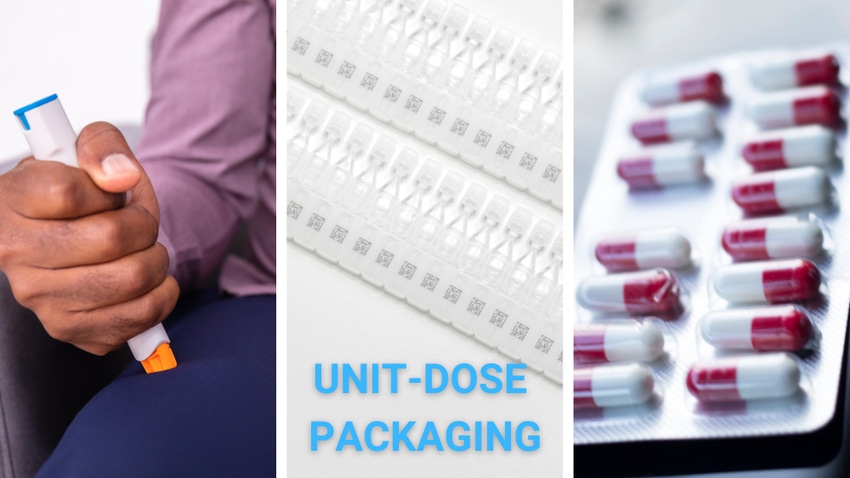Rapid Growth Expected for Unit-Dose Packaging
New injectable therapies and the popularity of personalized medicine are among the contributing factors.

Sales of unit-dose packaging are expected to rise over the next decade — thanks to a thriving pharmaceutical sector and the desire to decrease drug wastage by making it easier to use the product before it expires. Other key drivers include the growing need for personalized drugs and treatments tailored to individual patients.
The 21st Century Cures Act, which went into effect on December 13, 2016, supports this patient-centric approach to healthcare. The act was designed to generate innovations in product development and is expected to drive unit-dose packaging demand in the coming years.
According to Ismail Sutaria, Future Market Insights’ chief analyst and author of Pharmaceutical Unit Dose Packaging Market, unit-dose packaging is aligned with the Cures Act’s patient-centric focus because it involves the packaging of a single dose of medicine. This approach can enhance medication adherence, reduce errors, and simplify the administration of drugs for patients.
“As new and innovative drugs are developed, there may be a need for specialized packaging solutions to ensure accurate dosing and administration,” says Sutaria. “Unit-dose packaging can play a role in facilitating the delivery of these innovative treatments, especially when precise dosing is critical.”
Parenteral therapies, diabetes fuel trend.
Advancements in biotechnology are further expected to drive the growth of primary pharmaceutical packaging, like unit-dose packaging, resulting in the launch of new injectable parenteral therapies. Moreover, surging demand for high-visibility unit-dose packaging for diseases like diabetes is anticipated to fuel market expansion.
“Diabetes management often requires precise dosing of medications, ensuring accurate and consistent dosing. This is crucial for maintaining blood glucose levels within the target range,” says Sutaria. “Diabetes patients are at risk of medication errors, and unit-dose packaging minimizes that risk.”
Additionally, unit-dose packaging helps to maintain hygiene and reduce the risk of contamination. Managing diabetes requires strict adherence to medication schedules: Unit-dose packaging simplifies the administration process, making it easier for patients to adhere to their prescribed treatment regimens. Furthermore, unit-dose packaging allows for the customization of medication regimens based on individual patient needs.
Unit-dose complements advanced delivery systems.
Another factor contributing to the growth of unit-dose packaging is the development of advanced delivery systems. These include patient-friendly formats, such as auto-injectors, prefilled syringes, and inhalers.
“The integration of advanced delivery systems in unit-dose packaging can drive demand as advanced delivery systems often enable more precise dosing, allowing personalized and patient-specific medication regimens.”
“The integration of advanced delivery systems in unit-dose packaging can drive demand as advanced delivery systems often enable more precise dosing, allowing personalized and patient-specific medication regimens,” says Sutaria. “Unit-dose packaging aligns well with precision medicine based on individual patient needs.”
Additionally, advanced delivery systems are frequently associated with complex drug formulations, including biologics and specialty drugs. Unit-dose packaging helps to maintain the stability and integrity of these sensitive medications by providing a controlled and single-dose environment.
Convenience for patients and pharmacists.
Sutaria’s research shows that unit-dose packaging is convenient not only for patients but for pharmacists as well.
According to Sutaria’s report, the United States is experiencing strong medication adherence in the correctional setting. The imprisoned population in most correctional facilities depends on outside pharmacies to fill their prescriptions. An onsite pharmacist may be provided in some instances; however, such staff is generally restricted, depending on a central location to supply drugs and an onsite nurse manager to dispense them. This bolsters the case for dispensing administration systems, like unit-dose packaging, that are low effort for personnel yet ensure patient adherence.
Automation, regulations pose challenges.
Although growth prospects for unit-dose packaging are promising, potential barriers exist: Projected challenges to unit-dose market growth include the increasing costs of packaging due to changing regulations and laws, as well as the high costs of installing and maintaining automated systems.
Despite these potential obstacles, Sutaria reports that the global pharmaceutical unit-dose packaging market is expected to attain an impressive valuation of $34.2 billion in 2023 and is projected to reach $136 billion by 2033.
About the Author(s)
You May Also Like




